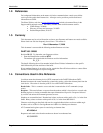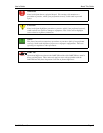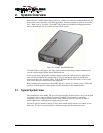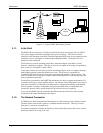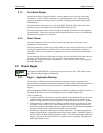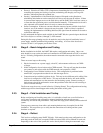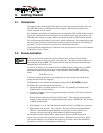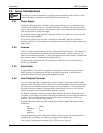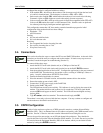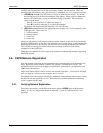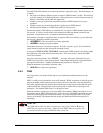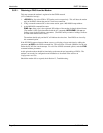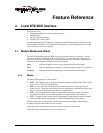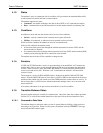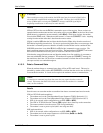
Introduction DART 300 Modem
Page 12 2110212 Rev 1.0
3.3. Set-up Considerations
The section covers the requirements for a simple test bench installation of the modem. For full
details of the physical installation of the DART 300 consult Section 10.
3.3.1. Power Supply
The DART 300 package does not include a power supply in the box, as most installations have
12V DC power available at the site. For this initial testing a 12.0V DC regulated power source
with a 1 amp capability is required. The unit comes with a power connector cable with bare wire
leads for connection to a DC power supply.
An AC power adapter, using the DART 300 power connector, is available as an accessory from
Sierra Wireless (part 6000082).
If you chose to provide your own cable, a description of the DART 300 power connector is
provided in Section 10.4. Part numbers are provided for those wishing to assemble custom power
supply cables.
3.3.2. Antenna
There is no antenna supplied with the modem as shipped from Sierra Wireless. The antenna you
choose to use should meet your particular installation requirements. Consult Section 10.1 for
details on the antenna requirements. A 3dB gain magnetic-mount cellular antenna, available from
most electronic stores, is suitable for bench testing activity.
An antenna with a hard mount and TNC connector is available as an accessory from Sierra
Wireless (part 6000065).
3.3.3. Serial Cable
A standard RS-232 serial cable with 9-pin male D connector is required (not provided in the
DART package) for connecting the PC host to the DART 300 modem. A suitable cable is
available from Sierra Wireless (part number 6000048) if needed.
3.3.4. Host Computer Terminal
You will require a PC with a communications program capable of operating in ASCII terminal
emulation mode. This allows the PC to function as a terminal attached to the modem and permits
the entering of AT commands required for modem set-up and diagnostics. We recommend that
the program chosen be capable of logging terminal communications activity to a file for later
analysis or printout in the event that technical support is required.
For IBM PC-compatibles, Windows Terminal, HyperTerminal, ProComm, and Kermit are all
acceptable. If you intend to use SLIP or PPP mode, note that early versions of HyperTerminal do
not allow you to send SLIP framing characters to the modem, preventing use of the escape
sequence. This was corrected in later versions.
Communication between the host (DTE) and the Sierra Wireless DART 300 modem is factory
defaulted to:
bps: 19200
Data Bits: 8
Parity: None
Stop Bits: 1
Any application being used to communicate with the modem and issue AT commands must be
configured this way initially. Auto-baud is not supported in the DART 300.
Flow control is implemented in hardware (RTS / CTS) and is not optional.



